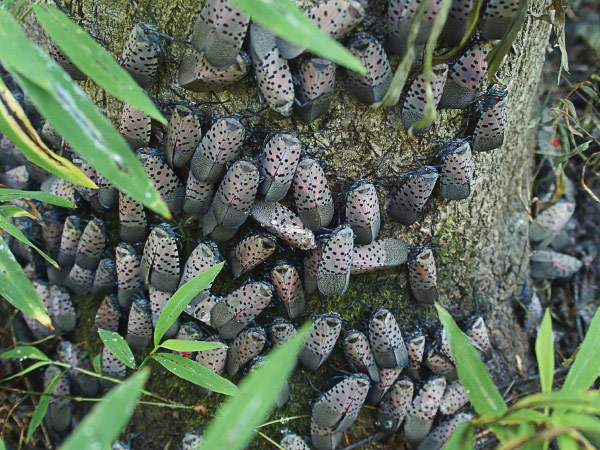Center-Funded Working Group Receives $7.3 Million USDA SCRI Grant to Advance Spotted Lanternfly Research
 |
|
The spotted lanternfly poses a significant threat to Pennsylvania agricultural industries. Photo by Emelie Swackhamer. |
By Amy Duke, The Pennsylvania State University
A version of this article first appeared in Penn State News.
The USDA has awarded a $7.3 million Specialty Crop Research Initiative (SCRI) grant to support an interdisciplinary, multi-institutional team of researchers as they conduct research and develop strategies to combat the spotted lanternfly (SLF).
The SLF working group, led by the Pennsylvania State University, was initially funded by the Northeastern IPM Center in the summer of 2018. The SCRI grant validates the severity of the SLF threat while greatly expanding the resources available to the team.
Enhanced Access to Funds and Farms
The grant, from the USDA’s National Institute of Food and Agriculture, will be complemented by more than $5 million in matching investments from growers and landowners who agreed to participate in this work, many of whom are currently working with researchers on SLF.
The $7.3 million USDA SCRI grant validates the severity of the SLF threat while greatly expanding the resources available to the team.
“I am extremely grateful to the USDA for this funding as well as the growers and landowners who pledged to allow us use of their farms for this project,” said project lead Julie Urban, associate professor of entomology in the Penn State College of Agricultural Sciences. “Our partnerships with them and other impacted stakeholders are key to arriving at strategies for sustainable, long-term management of this pest.”
Pest Range and Impacts
Pennsylvania has been the U.S. epicenter of the SLF problem to date, but the pest has begun to spread and will likely continue to do so. Native to Asia, it is now in 14 Pennsylvania counties and has been reported in surrounding states including New Jersey, New York, Delaware, Virginia, and Maryland.
SLF feeds on sap, weakening plants and leaving behind a sugary excrement called honeydew, which promotes the growth of sooty mold. This mold further harms the plant, while attracting other insects and creating a mess that can render outdoor areas unusable.
The pest threatens Pennsylvania’s grape, tree fruit, hardwood, and nursery industries, which collectively are worth about $18 billion to the state’s economy.
Grant to Support Several Key Goals
“I am extremely grateful to the USDA for this funding as well as the growers and landowners who pledged to allow us use of their farms for this project.”
– Project lead Julie Urban, associate professor of entomology in the Penn State College of Agricultural Sciences
The grant will support a four-year initiative aimed at achieving several goals, among them:
- To quantify the insect’s impact on at-risk specialty crops and immediately develop management tactics to reduce the damage in areas where SLF is established
- To perform essential fundamental research on the pest’s basic biology, ecology, and behavior, and to develop biological control tactics contributing to long-term sustainable solutions
- To deliver immediate management solutions to specialty-crop stakeholders and the public through the extension networks of the partnering land-grant universities, USDA agencies, and the Northeastern IPM Center
In addition, the funding will support training opportunities for graduate and undergraduate students and early-career postdoctoral scientists, thereby preparing the next generation of researchers and extension educators who will lead work on future invasive species.
Extensive Collaboration and Diverse Expertise
The project will draw on the expertise of 37 collaborating researchers and extension educators from Penn State, the USDA-Agricultural Research Service, the USDA-Animal and Plant Health Inspection Service, Virginia Tech, the University of Delaware, the University of Rhode Island, Temple University, Rutgers University, and the Northeastern IPM Center and other colleagues at Cornell University.
For More Information
To learn more about SLF, management techniques, and state-by-state instructions on how to report a sighting, visit stopslf.org.
The Penn State Extension website also provides extensive information on SLF—including the state-imposed quarantine in Pennsylvania—at extension.psu.edu/spotted-lanternfly.
The Northeastern IPM Center promotes integrated pest management for reducing risks to human health and the environment. If republishing our news, please acknowledge the source (“From Northeast IPM Insights”) along with a link to our website.
